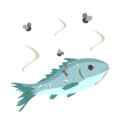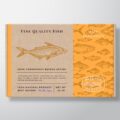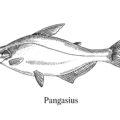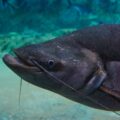Pangasius, commonly known as panga or swai, is a type of freshwater fish that has gained international popularity, particularly from its origin place, Vietnam. This white-fleshed fish is often marketed under various names, including basa, tra, and swai, and is commonly found in the frozen section of supermarkets. The mild-flavored, budget-friendly nature of this fish makes it an attractive option for consumers looking for an alternative to more expensive aquatic fare.

The edible nature of pangasius has been affirmed by various food safety authorities, making it safe for consumption when properly handled and cooked. It is rich in protein and can be prepared in a multitude of ways, making it versatile for a range of recipes. Due to its affordability and availability, pangasius has become a staple fish in many diets around the world. However, as with any widely consumed fish, it is important to consider the source of pangasius because farming practices can vary, and some may raise concerns about sustainability and quality.
Although pangasius is largely cultivated in Vietnam, it has raised questions about eco-friendliness, owing to the methods used in some farming operations. Consumers are advised to look for certification labels that ensure the pangasius they purchase is farmed in accordance with strict environmental and quality standards. These certifications help to guarantee that the pangasius is not just safe and nutritious to eat, but also produced with a lower environmental impact.
Nutritional and Health Information
Pangasius, a popular fish in culinary circles, offers a substantial amount of essential nutrients. The species contains omega-3 fatty acids, protein, and various vitamins and minerals conducive to health. Its nutritional profile provides a foundation for considering it as part of a healthy diet.
Benefits of Omega-3 Fatty Acids
Omega-3 fatty acids in pangasius contribute to cardiovascular health and are vital for brain function. They can help reduce inflammation and the risk of chronic diseases. The omega-3 content, although lower compared to fatty fish like salmon, still offers health benefits.
- Omega-3s: Essential for heart and brain health
- Mercury: Lower levels compared to many predatory fish
Protein, Vitamin, and Mineral Content
Pangasius is a good source of lean protein, essential for muscle growth and repair. It provides important B-vitamins like B12 and niacin, which aid in energy metabolism and maintaining healthy skin. Minerals such as selenium contribute to antioxidant defense, potassium aids in blood pressure control, iron is key for blood production, and calcium supports bone health.
- Protein: Supports muscle maintenance and growth
- Vitamin B12: Crucial for nerve function
- Niacin: Promotes a healthy metabolism
- Selenium: Acts as an antioxidant
- Potassium: Helps manage blood pressure levels
- Iron: Necessary for oxygen transport in the body
- Calcium: Essential for bone health
Caloric Content and Fat Composition
Pangasius is low in calories and fat, making it an appropriate choice for weight management. It has a moderate cholesterol content and a low sodium level, which can aid in maintaining a healthy blood pressure and supporting heart health.
- Calories: Low, contributing to weight management
- Fat Composition: Predominantly healthy unsaturated fats
- Cholesterol: Moderate levels, important for cellular function
- Sodium: Naturally low, beneficial for blood pressure
Environmental and Economic Aspects
Pangasius farming presents significant environmental and economic challenges and opportunities, particularly concerning sustainable development and aquaculture practices. This section explores the deep interplay between these aspects and their global implications.
Sustainability of Pangasius Farming
Southeast Asia, particularly Vietnam, is a major player in Pangasius aquaculture. The farming of Pangasius, also known as Vietnamese catfish, predominantly occurs along the Mekong River. Sustainability concerns arise due to the impact on freshwater sources and local ecosystems. Organizations such as the Aquaculture Stewardship Council (ASC) and the Marine Stewardship Council (MSC) aim to address these concerns through certifications that promote responsible farming practices.
- ASC Certification:
- Focus on environmental and social responsibility
- Requires compliance with stringent standards
- MSC Certification:
- Emphasis on sustainable fishing practices
- Encourages maintenance of stock levels and minimization of environmental impact
The Monterey Bay Aquarium’s Seafood Watch program also contributes to sustainability by guiding consumers toward environmentally friendly seafood options, including certified Pangasius.
Aquaculture Practices
The economic implications of Pangasius farming are significant. With the growing global demand for affordable seafood, farmers and nations partake in intensive aquaculture to boost production and improve economic gains. Fish farms use a variety of techniques to enhance efficiency and productivity, but these must be balanced against environmental considerations.
- Aquaculture Techniques:
- Closed water recirculation systems: Reduce pollution and disease spread
- Open net pens in rivers: Can lead to water pollution and affect wild fish populations
- Polyculture systems: Combine Pangasius with other species to mimic natural ecosystems
The challenge lies in implementing aquaculture practices that sustain the economic vitality of the industry while preserving the ecological balance of the freshwater habitats. Hence, sustainable fishing and responsible farm management remain critical to the long-term viability of the Pangasius industry.
Safety and Quality Concerns
In assessing the safety and quality of Pangasius, it is crucial to consider potential risks from contaminants and chemical usage, as well as issues related to mislabeling. Closely regulated practices and thorough testing are required to ensure consumer health.
Risk of Contaminants and Chemical Usage
1. Antibiotics and Chemicals: Pangasius farms often use antibiotics and chemicals to prevent disease and promote growth. However, the residues of these substances can be harmful if not regulated properly.
- Antibiotics: Misuse can lead to drug-resistant bacteria.
- Chemicals: Overuse can result in chemical accumulation in tissue.
2. Heavy Metals and Mercury: Pangasius may be exposed to heavy metals and mercury from contaminated waters.
- Heavy Metals: Includes cadmium, lead, and arsenic.
- Mercury: High levels can affect the nervous system.
3. Contaminants and Toxins: Pangasius can accumulate various toxins and contaminants depending on their environment.
- Waste: Poor water quality due to waste can introduce harmful bacteria.
- Vibrio Bacteria: These can cause foodborne illnesses.
- Parasites: May be present if fish are harvested from unclean waters.
Mislabeling and Fraudulent Substitution
1. Mislabeling: Instances of mislabeling Pangasius as other types of fish are a concern for both safety and ethics.
- Species Confusion: Can lead to ingestion of unknown allergens or toxins.
- Economic Fraud: Deceives consumers and undermines genuine products.
2. Fraudulent Substitution: Illegitimate substitution not only undermines consumer trust but can also expose them to untested and potentially harmful products.
- Incorrect Species: May carry different health risks.
- Drug Residues: Unregulated products can have unchecked levels of drug residues.
In conclusion, the safety and quality of Pangasius are influenced by multiple factors including chemical and antibiotic use, potential for contaminants such as heavy metals, mercury, toxins, and parasites, as well as the integrity of labeling practices. Ensuring responsible farming and accurate labeling is key to addressing these concerns.
Culinary Attributes and Usage
Pangasius, also known as pangasius hypophthalmus or cream dory, is a white-fleshed fish that has become popular due to its versatility in cooking and its mild, neutral flavor that makes it an excellent canvas for a variety of ingredients.
Comparison with Other Fish Varieties
Pangasius vs. Salmon:
- Flavor: Salmon has a richer flavor compared to pangasius, which is milder and often described as neutral.
- Texture: Salmon is known for its firm texture, while pangasius tends to be softer and moist.
Pangasius vs. Cod:
- Flavor: Cod and pangasius share a subtle, mild taste, but cod may have a slightly sweeter note.
- Texture: Both fish have a moist, firm texture, although cod fillets can be thicker and flakier.
Preparing and Cooking Pangasius
Nutritional Aspects:
- Pangasius is lower in omega-3 fatty acids than salmon but is a lean source of protein with minimal carbs, making it a suitable option for various diet plans.
- It’s often present on restaurant menus as a lower-cost alternative with decent nutritional value.
Cooking Techniques:
- Fish Fillets: Pangasius is commonly sold as skinless, boneless fillets, which can be grilled, baked, steamed, or fried with a range of seasonings and sauces.
- Ingredients Pairing: Due to its neutral flavor, pangasius pairs well with bold spices, citrusy flavors, and creamy sauces.











